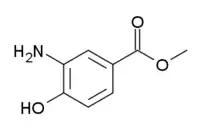 | |
| Names | |
|---|---|
| Preferred IUPAC name
Methyl 3-amino-4-hydroxybenzoate | |
| Other names
aminobenz | |
| Identifiers | |
3D model (JSmol) |
|
| 3-14-00-01477 | |
| ChemSpider | |
| ECHA InfoCard | 100.007.845 |
| EC Number |
|
| KEGG | |
PubChem CID |
|
| UNII | |
CompTox Dashboard (EPA) |
|
| |
| |
| Properties | |
| C8H9NO3 | |
| Molar mass | 167.16196 |
Except where otherwise noted, data are given for materials in their standard state (at 25 °C [77 °F], 100 kPa).
Infobox references | |
Orthocaine is a local anesthetic. Developed in the 1890s, it was found to be of limited use due to its low solubility in water, but it has been used in powdered form to dust onto painful wounds.[1][2][3]
References
- ↑ Walter Sneader (23 June 2005). Drug Discovery: A History. John Wiley & Sons. pp. 127–9. ISBN 978-0-471-89979-2.
- ↑ Rajbir Singh (2002). Synthetic Drugs. Mittal Publications. pp. 167–8. ISBN 978-81-7099-831-0.
- ↑ Stanley Alstead (22 October 2013). Poulsson's Text-Book of Pharmacology and Therapeutics. Elsevier. pp. 104–5. ISBN 978-1-4832-2584-5.
This article is issued from Wikipedia. The text is licensed under Creative Commons - Attribution - Sharealike. Additional terms may apply for the media files.